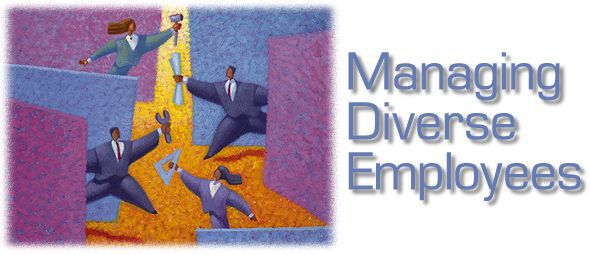
 |
|
Introduction to Workforce Diversity Implementing Diversity Exercise: Where
do you stand Company Profiles: |
Introduction to Workforce Diversity What is Workforce Diversity by USDA. Concise definition of workforce diversity that encompasses the "Four Layers of Diversity" model: Personality, Internal Dimension, External Dimension and Organizational Dimension. Workforce Diversity: A Business Imperative in the Global Economy by KSA Group. This article builds a business case for workforce diversity, especially for multinational companies that have the opportunity to tap into the talents of individuals in the countries where they operate. Procter & Gamble, TRW, DuPont and Ford are all profiled. DiversityInc.com "on-line magazine that provides news, resources and commentary on the role of diversity in strengthening the corporate bottom line." |
|
Implementing Diversity Programs Training Can Damage Diversity Efforts by Shari Caudron, Workforce. (Workforce requires that you complete a free registration before gaining access to its articles). Originally printed in Personnel Journal, April 1993, Vol. 72, No. 4, pp. 50 - 62.
Strategies To Measure The Results Of Diversity Management by Bobby Siu, Workplace Diversity Update (416). Four steps are discussed for making diversity programs more accountable:
Do You Have the Right Approach to Diversity? By Gillian Flynn, Workforce. (Workforce requires that you complete a free registration before gaining access to its articles). Originally printed in Personnel Journal, October 1995, Vol. 74, No. 10, pp. 68-75. Detailed advice on how to ensure that diversity programs get results by::
The Harsh Reality of Diversity Programs By Gillian Flynn, Workforce, December 1998, Vol. 77, No. 12, pp. 26-35. (Workforce requires that you complete a free registration before gaining access to its articles). The article explores:
At Your Library What Blacks Think Of Corporate America by Shelly Branch, Fortune, Vol 138, July 6, 1998, page 140+ . Find out the results of a survey of 750 respondents who rated their companies on such factors as providing equal hiring, promotion and pay opportunities for blacks, whether or not corporations have improved in offering equal opportunities and the effectiveness or ineffectiveness of affirmative action programs. The survey also asked about respondents about their degree of optimism about their career futures and their opinions about anti-discrimination laws. The article also provides commentary and analysis of the survey results. |
|
|
Training Women for Corporate Leadership, by Michelle Martinez, HR Magazine, April,1997. The article offers:
Cracking the Glass Ceiling Few Women CEOs, but Change Is Coming, by Neil Glass, ABCNEWS.com, January 4, 1999. Describes the trend towards greater opportunities for women in management at mid-sized companies and in the entrepreneurial world. Also included are profiles of two women who reached executive positions in their firms. Deloitte & Touche LLP: Optimas Award Profile By Gillian Flynn, Workforce. (Workforce requires that you complete a free registration before gaining access to its articles) Originally printed in Personnel Journal, April 1996, Vol. 75, No. 4, pp. 56-68. When Deloitte & Touche discovered that it was losing a disproportionate number of female accountants, the company decided to investigate the reasons and then solve the problem. This article describes their journey, including what they found out, their recommendations for change and the results of their efforts. Breaking Through the Glass Ceiling by Ingrid Becker, women.com. Summary of Carol Gallagher's Ph.D. research about women who "break through the glass ceiling" to reach top positions in their organizations. Among the successful approaches that are discussed: taking risks, building a network of contacts and strategic alliances inside and outside the organization and staying in the loop through meetings and other communications. Lack of promotion leaves minority female execs dissatisfied by Maggie Jackson, Associated Press, June 16, 1998. Commentary and summary of the results of a poll of 1700 minority female executives, such as the percentages who plan to leave their companies and who are satisfied with their opportunities for advancement. Glass Ceiling Still Intact Summary and analysis of the "1996 Catalyst Census of Women Corporate Officers and Top Earners." A sample of the findings:
|
|
|
What is sexual harassment in the workplace? by The Law Offices of David H. Greenberg. Precise definitions of two types of sexual harassment: "quid-pro-quo" and "hostile environment." If you are interested in a detailed primer for lawyers that explores these terms in much more detail, as well as applicable court cases, see the Primer on Sexual Harassment in the Workplace, by Barry S. Roberts and Richard A Mann.
|
|
Copyright © 1999-2001 South-Western, A Cengage Learning Company.
All rights reserved.
For problems or suggestions concerning this service, please contact Internet Webmaster.